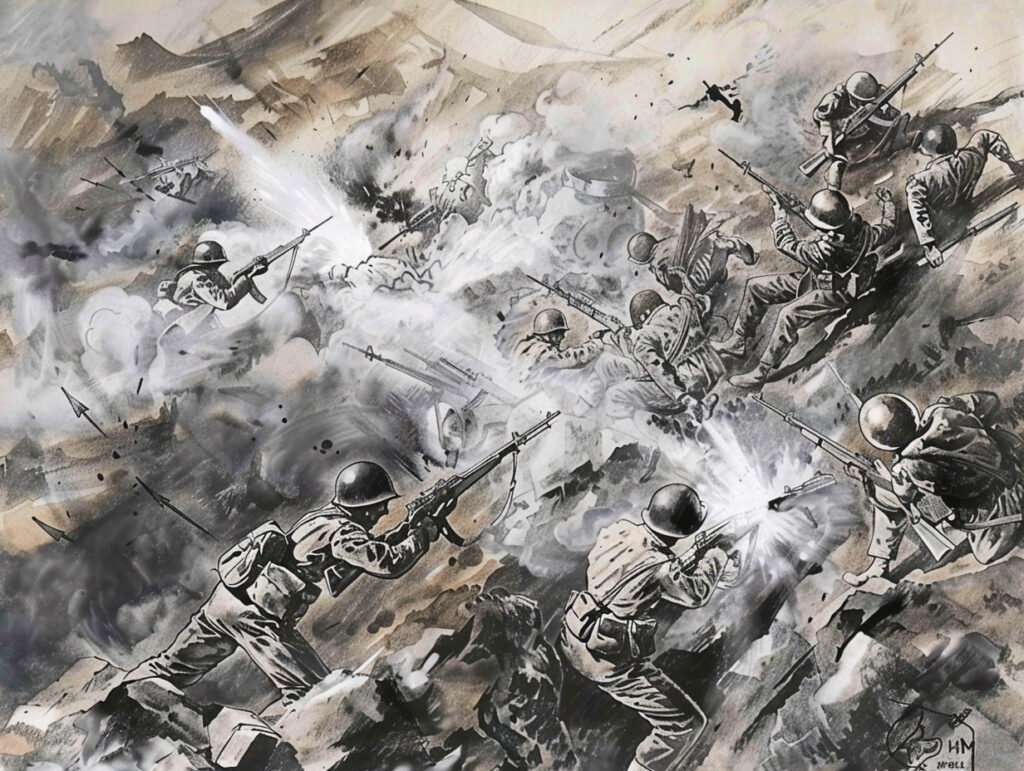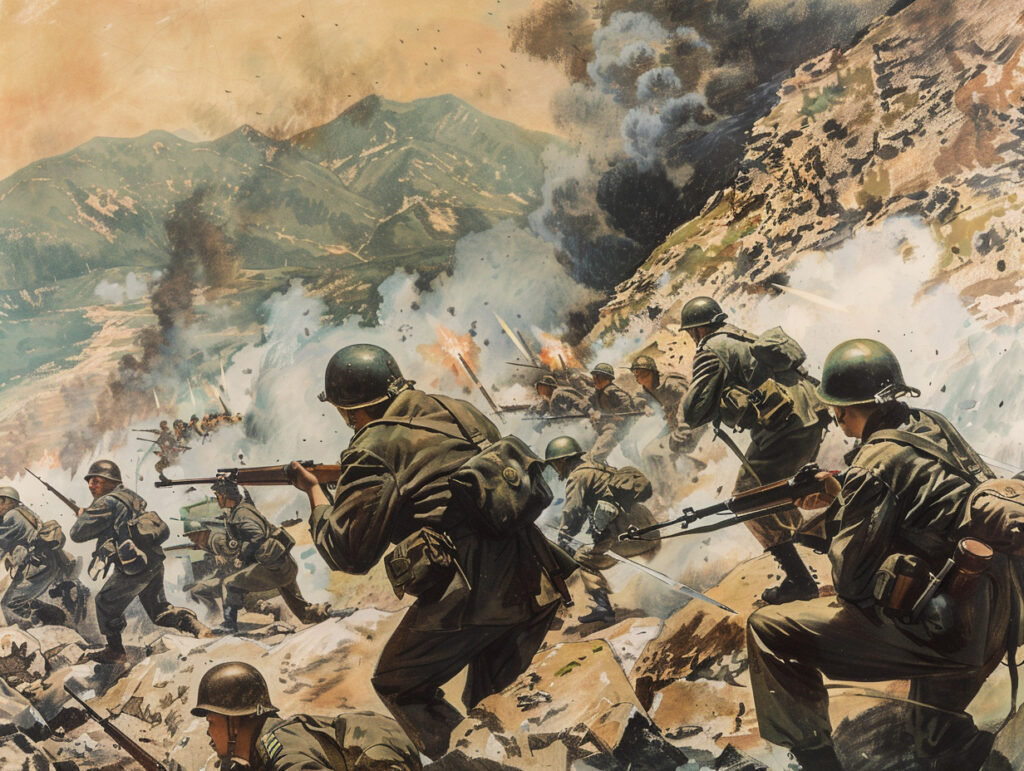The Greek Civil War (1946-1949) was a brutal conflict between communist insurgents and the Greek government, deeply influenced by post-WWII geopolitics.
The Greek Civil War (1946-1949) stands as a significant post-World War II conflict, marked by its ideological struggle between communist insurgents and the government of Greece. It was a war that not only shaped the future of Greece but also reflected the broader tensions of the emerging Cold War between the Soviet Union and the Western powers. The conflict’s origins lay in the aftermath of World War II, the vacuum of power left by Axis occupation, and the clashing visions for Greece’s future.
Reasons for the Greek Civil War (1946-1949)
The roots of the Greek Civil War can be traced back to the power vacuum created by the Axis occupation during World War II. As Nazi Germany withdrew, Greece was left in a state of political and social turmoil. The main resistance forces during the occupation were the communist-dominated National Liberation Front (EAM) and its military wing, the Greek People’s Liberation Army (ELAS). These groups sought to establish a socialist state post-liberation. Conversely, the Greek government-in-exile, backed by the British and later the Americans, aimed to restore the pre-war monarchy and a conservative government.
Tensions escalated as both sides vied for control in the power vacuum. The December 1944 clashes in Athens, known as the Dekemvriana, saw British forces and the Greek government battling ELAS fighters, leading to a temporary armistice. However, the underlying ideological conflict remained unresolved. The Yalta Conference’s agreements and the ensuing geopolitical divide further fueled the tensions. The Truman Doctrine in 1947, with its promise of American support to governments resisting communism, galvanized the Greek government to take a hard stance against the communist insurgents. These combined factors created a volatile environment that erupted into full-scale civil war in 1946.

Who was Involved in the Greek Civil War (1946-1949)
The Greek Civil War primarily pitted the Greek government, supported by Britain and later the United States, against the Democratic Army of Greece (DSE), backed by the Greek Communist Party (KKE) and indirectly by Yugoslavia, Albania, and Bulgaria. The government forces included the National Army, bolstered by foreign military aid and advisors.
The DSE, formed by former members of ELAS, received logistical support and safe havens from neighboring communist countries. Key figures in the government included Prime Minister Konstantinos Tsaldaris and military leaders such as General Alexandros Papagos. On the communist side, key leaders were Nikos Zachariadis, the Secretary-General of the KKE, and Markos Vafiadis, a prominent commander in the DSE.
The conflict also drew in civilian populations, with widespread atrocities and reprisals committed by both sides. The involvement of foreign powers turned Greece into a Cold War battleground, with the U.S. viewing the war as a critical front in containing communism. British involvement waned as American support increased, reflecting the shifting dynamics of post-war geopolitics.
The Leaders of the Greek Civil War (1946-1949)
Konstantinos Tsaldaris, the Greek Prime Minister during much of the civil war, was a key government figure advocating for a return to a conservative, monarchist Greece. General Alexandros Papagos, a seasoned military leader, played a crucial role in reorganizing and leading government forces against the DSE.
On the communist side, Nikos Zachariadis, the Secretary-General of the KKE, was a staunch advocate for a socialist Greece and directed much of the DSE’s strategy. Markos Vafiadis, a charismatic and skilled commander, led the DSE forces in numerous key battles until internal party disagreements led to his replacement by Nikolaos Ploumpidis.
Tsaldaris continued his political career after the war, while Papagos became a national hero, eventually serving as Prime Minister. Zachariadis, after the communist defeat, was exiled and later faced internal party purges. Vafiadis and other communist leaders faced imprisonment or exile, with their political influence greatly diminished in post-war Greece.
Was There a Decisive Moment
The transition from tension to open warfare was marked by the failure of peace talks in early 1946. The DSE’s decision to resume armed struggle in March 1946, coupled with the symbolic attack on the police station in Litochoro, signaled the start of open conflict. This attack demonstrated the determination of the communists to achieve their goals through force, pushing the country into a brutal civil war.
Major Battles of the Greek Civil War (1946-1949)
Battle of Litochoro (March 1946): The war began with the DSE’s attack on a police station in Litochoro. This small yet symbolic engagement marked the transition to open conflict.
First Battle of Mount Grammos (June-October 1948): One of the largest and most significant battles, the First Battle of Mount Grammos saw government forces launching a major offensive to dislodge DSE fighters from their stronghold in the rugged mountains. General Alexandros Papagos led the National Army, employing superior numbers and firepower. Despite fierce resistance, the government forces managed to capture key positions, but the DSE retreated into the nearby Vitsi mountains, avoiding total defeat.
Battle of Mount Vitsi (August 1948): Following their withdrawal from Grammos, the DSE regrouped in Vitsi. Government forces continued their pursuit, resulting in another major battle. This engagement saw extensive use of artillery and air support by the government, ultimately forcing the DSE to retreat once again, this time suffering significant losses in men and materiel.
Second Battle of Mount Grammos (August 1949): The second offensive against Grammos was decisive. By this time, the National Army had grown stronger with American support, including better equipment and training. General Papagos implemented a coordinated assault, combining ground and air operations to encircle and crush the DSE forces. The fall of Grammos marked the effective end of organized DSE resistance.
Battle of Konitsa (December 1947-January 1948): The DSE attempted to capture the town of Konitsa to establish a provisional government. Despite initial successes, government forces, with superior firepower and air support, repelled the attack. The failure to capture Konitsa was a significant setback for the DSE.
These battles showcased the strategic importance of mountainous terrain and the impact of foreign aid on the conflict’s outcome. The government’s ability to adapt and leverage superior resources ultimately led to their victory, while the DSE’s lack of external support and internal divisions contributed to their defeat.
Was There a Turning Point
The turning point of the Greek Civil War came in 1948 when Tito of Yugoslavia broke with Stalin and subsequently stopped supporting the Greek communists. This loss of critical logistical support weakened the DSE significantly. Simultaneously, increased American military aid through the Truman Doctrine bolstered government forces, allowing for decisive victories in battles such as the Second Battle of Mount Grammos in 1949, leading to the collapse of the DSE’s organized resistance.

Consequences of the Greek Civil War (1946-1949)
The Greek Civil War had profound consequences for Greece and the broader geopolitical landscape. Domestically, it resulted in severe political and social divisions, with widespread devastation and loss of life. Approximately 158,000 people died, and thousands more were displaced. The war solidified Greece’s position as a staunch anti-communist state, aligning it closely with the West during the Cold War.
Politically, the victory of the government forces led to the establishment of a conservative regime that suppressed leftist movements for decades. Many former DSE fighters and sympathizers faced imprisonment, execution, or exile. The war also accelerated Greece’s integration into Western military and economic structures, culminating in its membership in NATO in 1952.
Internationally, the war highlighted the strategic importance of Greece in the early Cold War period. It underscored the effectiveness of the Truman Doctrine in containing communism and set a precedent for American intervention in other conflicts. The conflict also strained Greece’s relations with its northern neighbors, who had supported the DSE.
The Greek Civil War was a critical episode in post-World War II history, reflecting the broader ideological battle between communism and capitalism. It reshaped Greece’s political landscape, entrenched Cold War divisions, and had lasting impacts on the region’s stability. The war’s legacy continues to influence Greek politics and society, serving as a reminder of the deep divisions and the high stakes of ideological conflicts.
Back to the Wars section